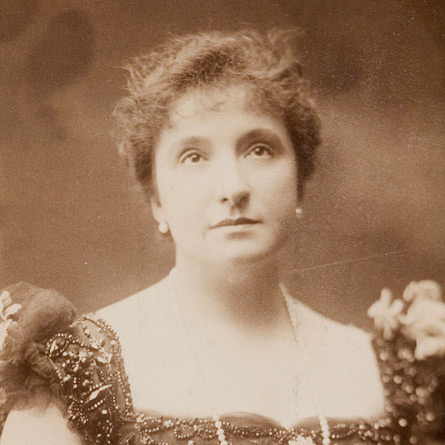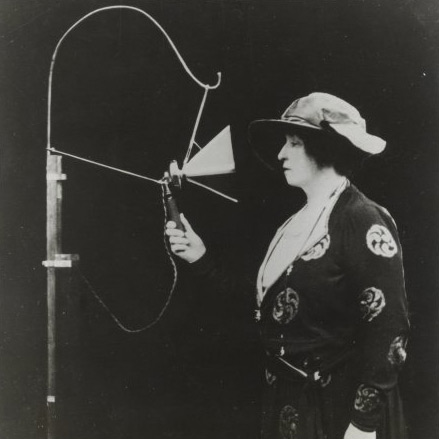Nellie Melba
On the 19 May 1861, Nellie Melba was born Helen Porter Mitchell, in Richmond, Melbourne. Her father, David Mitchell was a strict businessman and her mother, Isabella, a musician who passed on her talents to her daughter Nellie.
Nellie first attended boarding school in Richmond before transferring to the new Presbyterian Ladies' College, a school her father had petitioned to have established. At PLC she showed little interest in mathematics and english, choosing to focus instead on her singing and piano lessons.
Following her mother’s death in her final year of school, Melba travelled with her father to the small Queensland town of Mackay where she met the handsome Charles Armstrong. The couple married in Brisbane in 1882, and two years later had their first and only child, George.
After making her debut at the Melbourne Town Hall, the ambitious Nellie was eager to find opportunities on the international stage and so accompanied her father to London. Making use of her contacts, she travelled to Paris to audition for the highly respected teacher Mathilde Marchesi, who immediately recognised her potential, even if she didn’t like her name. On Marchesi’s advice, she adopted a new stage name that was ‘short, memorable and Italianate’: Nellie Melba.
'Nellie’ was the name given to her by her younger brothers and sisters and ‘Melba’, a tribute to her hometown of Melbourne.
In 1887, Nellie Melba made her début as an opera singer at the Théâtre Royal de la Monnaie in Brussels, where her performance was widely acclaimed. Returning to London, she appeared for the first time at Covent Garden, but it was not until her performance there in Roméo et Juliette that she achieved a personal milestone in her career. 'I date my success in London', she later recalled, 'quite distinctly from the great night of 15 June 1889'.
Following an outstanding performance at Covent Garden in 1892, Melba was honoured by French chef Auguste Escoffier with a dessert that featured an ice swan on a bed of vanilla ice cream, topped with peaches and spun sugar.
Melba’s fame was such that when travelling to distant places in Europe and the USA, she was mobbed by her fans and the press, much the same as celebrities are today. Her name became associated not only with the great operas, but also a range of popular household products and food, including the famous ‘Peche Melba’. Melba tried to make a stand, saying,
While I have no objection to Pêche Melba, I do have the strongest objection to my name being calmly taken for any object which the proprietor considers suitable – from scent to hairpins.
While achieving international success on the stage, Melba’s private life was shaping up to be less than brilliant. Her relationship with Charles had grown distant and in 1890, the couple were divorced. By this time her son, George was living in America with his father.
When Melba made her long awaited return to Australia in 1902, she embarked on a series of performances across every state. In 1909, she followed up with a tour of over 16,000kms, travelling with two baby grand pianos by train to remote parts of the country. Everywhere she went, she was greeted with banquets, speeches and cheers. The public loved Melba and she equally loved their adoration.
After the war, Melba made return visits to London and, in 1920, became the first international artist to participate in direct radio broadcasts. To the delight of her listeners, she sang two arias and her famous trill. In a message published in the Sydney Morning Herald she said proudly,
To my thousands of friends throughout the British Empire I take this wonderful opportunity of sending greetings. It was my privilege to be the first Australian artist to broadcast in England… I hope that the day will soon arrive when the world's great artists will be heard in every part of the Empire by radio.
In April 1927, Melba became the first Australian to appear on the cover of Time magazine.
In 1926, Melba announced her farewell to opera, though it would be two more years before she performed her final concert in Geelong. Her extended departure from the stage coined the phrase ‘doing the Melba’, referring to a prolonged a goodbye.
The Dame on the $100 Note
Dame Nellie Melba has featured on the $100 polymer note since it was first issued in 1996.
Look closely at the $100 note. What do the images in the background represent?
Travelling through Europe and Egypt, Melba decided to return home after developing a terrible fever. With deteriorating health, she sought medical care at St Vincents Hospital in Sydney, where she died on 23 February 1931.
Melba received a state funeral and was buried close to her home near Lilydale, Victoria. Her headstone bears the words of her favourite character, Mimi, in La Bohème: ‘Addio, senza rancor’ (farewell without bitterness).



